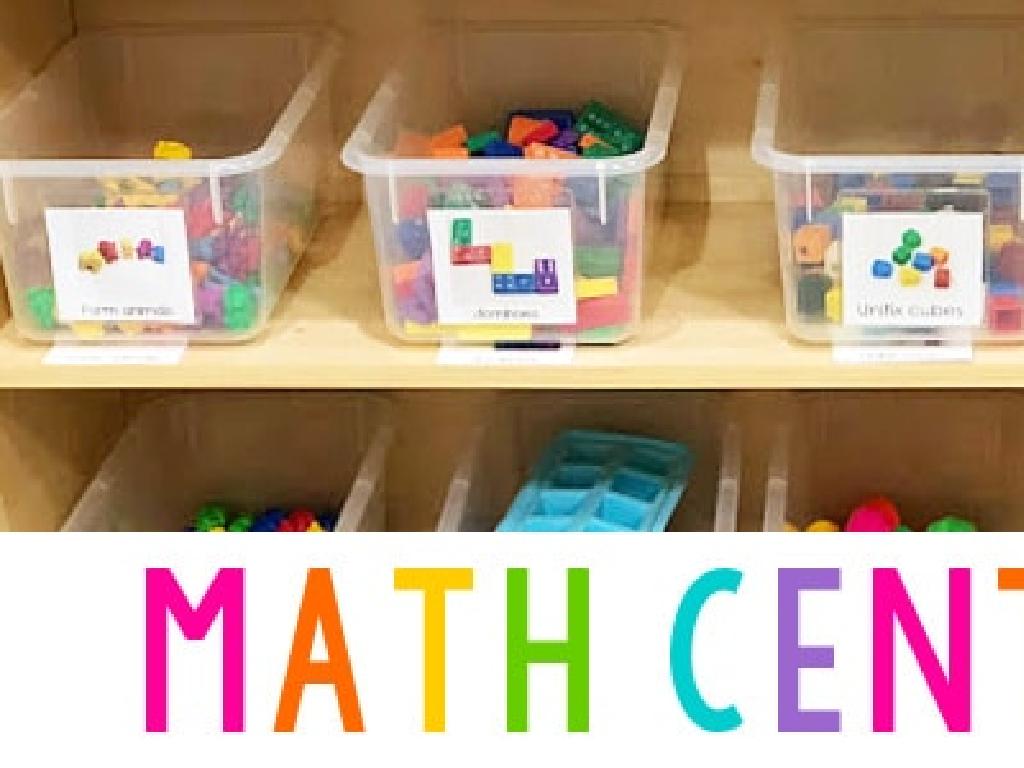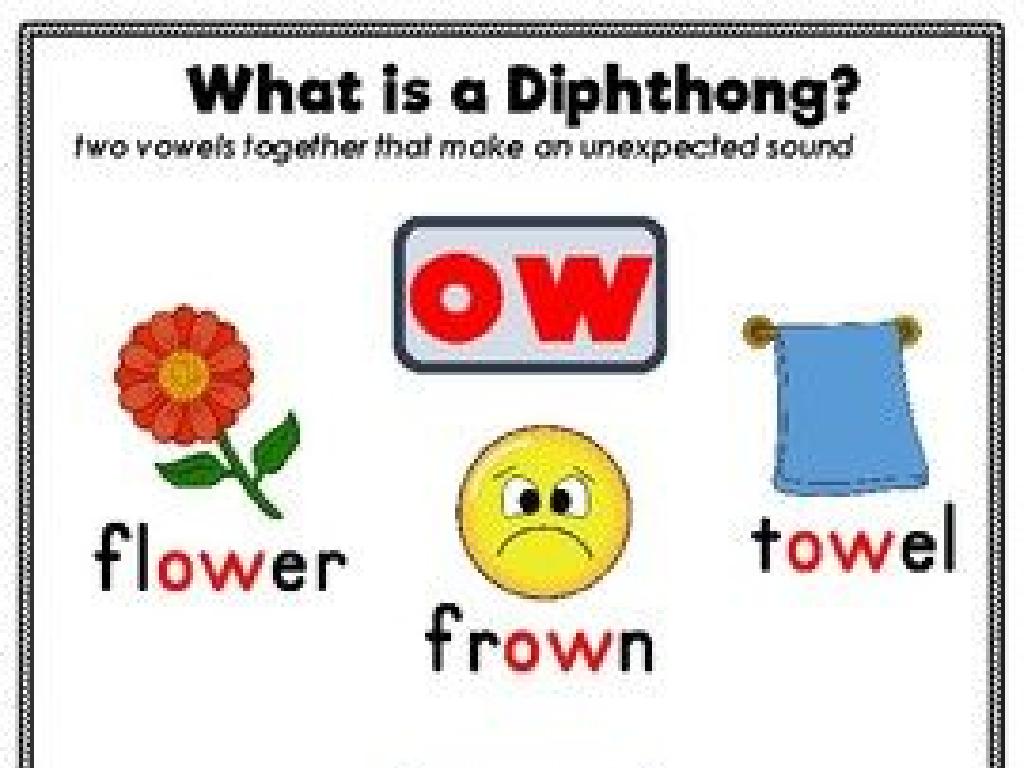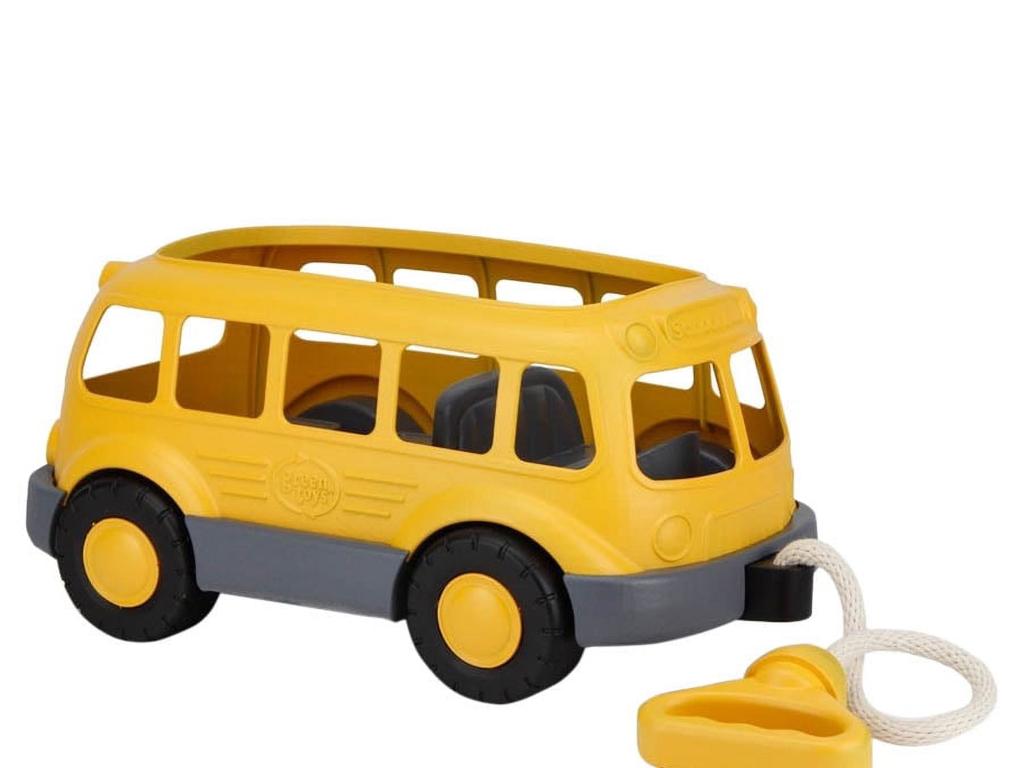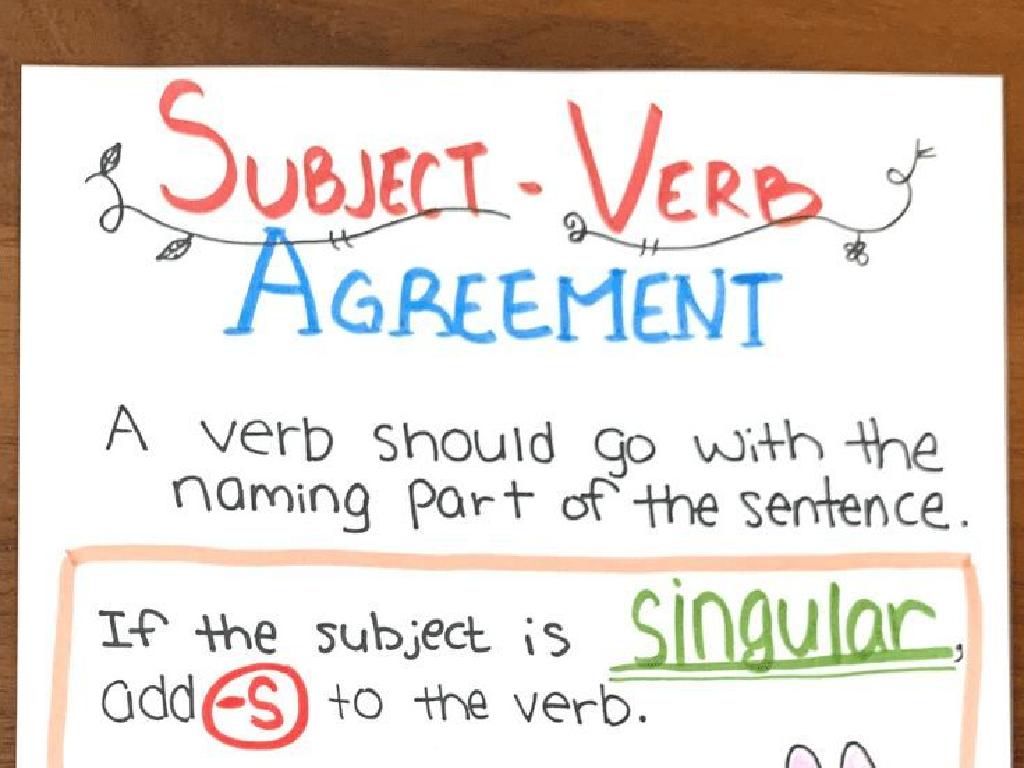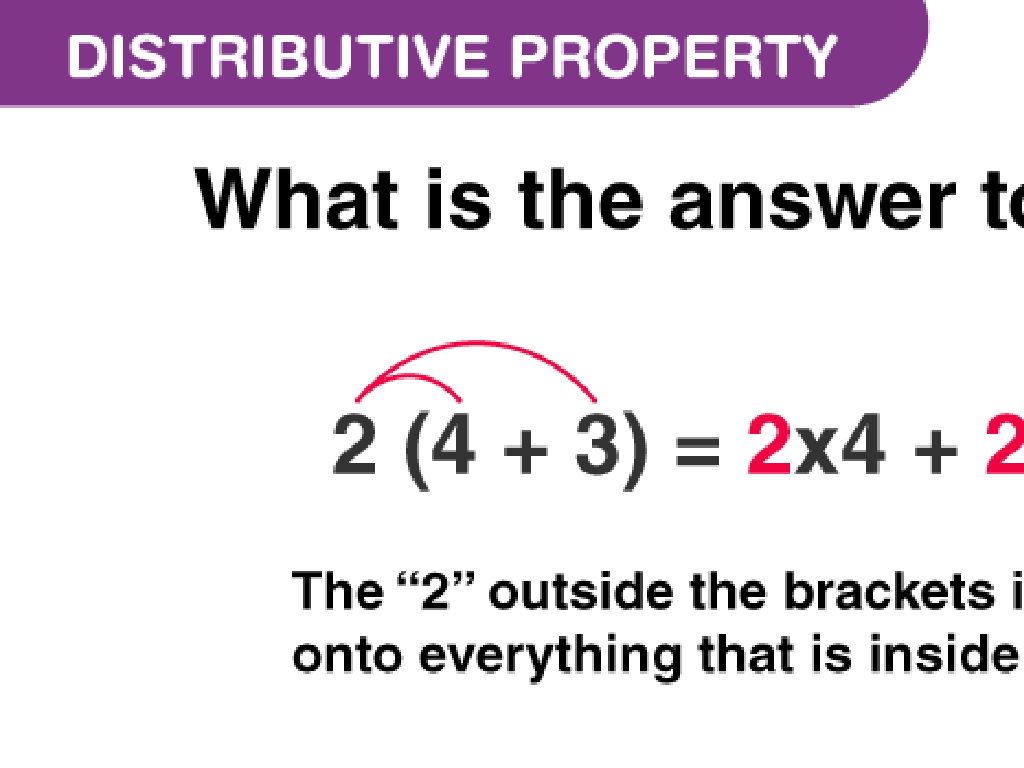Identify Syllable Types
Subject: Language arts
Grade: Third grade
Topic: Multisyllabic Words
Please LOG IN to download the presentation. Access is available to registered users only.
View More Content
Welcome to Multisyllabic Words!
– What are syllables?
– Syllables are like beats in words.
– Syllables help with reading
– Knowing syllables helps us read big words.
– Syllables help with writing
– We can spell better by writing one syllable at a time.
– Breaking words into parts
– We’ll practice splitting words like ‘fantastic’ into ‘fan-tas-tic’.
|
This slide introduces the concept of syllables to third-grade students, emphasizing their importance in reading and writing. Begin by explaining that syllables are the individual units of sound that make up words, much like beats in music. Illustrate how understanding syllables can make challenging words less intimidating by breaking them down into manageable parts. Provide examples of multisyllabic words and demonstrate how to divide them into syllables. Encourage students to clap out syllables to reinforce the concept. The goal is for students to apply this knowledge to improve their reading fluency and spelling accuracy.
Exploring Syllables in Words
– What’s a syllable?
– A word chunk with one vowel sound
– Counting syllables in words
– Each syllable has one vowel sound
– Words can have many syllables
– Some words are short, some are long
– Clapping out syllable rhythms
– Clap once for each syllable you hear
|
This slide introduces the concept of syllables to third-grade students. A syllable is defined as a part of a word that contains a single vowel sound. Emphasize that words can be made up of one or more syllables. To make this interactive, demonstrate clapping for each syllable in a word to help students identify the number of syllables. For example, ‘hap-py’ has two claps. Encourage students to practice with different words and to listen for the vowel sounds that signify each syllable. This activity will help them break down multisyllabic words and improve their pronunciation and spelling skills.
Exploring Syllable Types
– Understanding syllable types
– A syllable is a word part with one vowel sound.
– Rules for each syllable type
– Each syllable type has a unique pattern.
– Closed vs. Open syllables
– Closed syllables end in a consonant, open syllables end with a vowel.
– Vowel-Consonant-e and R-Controlled
– Vowel-Consonant-e has a silent ‘e’, R-Controlled has a vowel followed by ‘r’.
|
This slide introduces the concept of syllable types to third-grade students. Begin by explaining what a syllable is and how it forms part of a word. Discuss the ‘rules’ that define each type of syllable, such as the presence of a vowel sound in each syllable. Introduce Closed syllables, which end in a consonant and typically have a short vowel sound, versus Open syllables, which end in a vowel and usually have a long vowel sound. Explain Vowel-Consonant-e syllables, where the ‘e’ is silent and makes the preceding vowel long, and R-Controlled syllables, where the ‘r’ changes the sound of the vowel before it. Use examples like ‘cap’ (Closed), ‘he’ (Open), ‘cake’ (Vowel-Consonant-e), and ‘car’ (R-Controlled). Encourage students to practice by breaking down multisyllabic words into their syllable types.
Understanding Closed Syllables
– Closed syllable ends in a consonant
– Like ‘cap’, ‘sit’, or ‘top’, ending with a consonant
– Vowel sound in closed syllables is short
– The ‘a’ in ‘cat’ sounds short, not like ‘cake’
– Example: ‘cat’ is a closed syllable
– ‘cat’ has one syllable that ends with ‘t’
|
This slide introduces the concept of closed syllables, which are foundational for understanding syllable types in multisyllabic words. Emphasize that a closed syllable will end in a consonant and this often makes the vowel sound short. Use common one-syllable words as examples to illustrate the concept. Encourage students to practice by identifying closed syllables in their reading or by creating a list of words that fit this pattern. This will help them with decoding larger words in the future.
Understanding Open Syllables
– Open syllable ends in a vowel
– It doesn’t have a consonant at the end
– Vowel usually has a long sound
– Like in ‘go’ or ‘we’, the vowel says its name
– Example: ‘he’ is an open syllable
– The word ‘he’ has one syllable that is open
|
This slide introduces the concept of open syllables to third-grade students. An open syllable is one that ends in a vowel and does not have a consonant closing it off, resulting in the vowel typically having a long sound. Use examples like ‘he’, ‘we’, and ‘go’ to illustrate this concept. Explain that in these cases, the vowel ‘says its name,’ which is a common way to describe long vowel sounds to young learners. Encourage students to think of other examples and to listen for the long vowel sounds in open syllables during reading exercises.
Understanding Vowel-Consonant-e Syllables
– Syllable ends with vowel, consonant, ‘e’
– Like in ‘bike’, where ‘i’ says its name
– The ‘e’ is silent, vowel sounds long
– ‘a’ in ‘cake’ says ‘A’ because of the silent ‘e’
– Example: ‘cake’ has one syllable
– ‘cake’ is broken down as ‘cak-e’, but we say ‘kayk’
|
This slide introduces the Vowel-Consonant-e syllable type, which is a common pattern in English where the final ‘e’ in a word is silent, causing the preceding vowel to be pronounced as a long vowel (it says its name). Use examples like ‘cake’, ‘bike’, and ‘note’ to illustrate this concept. Explain that even though the ‘e’ is not pronounced, it’s crucial for the correct pronunciation of the vowel. Have students practice identifying and pronouncing Vowel-Consonant-e syllables in different words to reinforce the lesson.
R-Controlled Syllables
– Vowel followed by an ‘r’
– ‘r’ changes the vowel sound
– Example: ‘car’
– ‘car’ has the ‘ar’ sound, making it R-Controlled
– Practice with different words
– Try ‘star’, ‘bird’, ‘turn’. What sound do you hear?
|
This slide introduces R-Controlled syllables, which are an important concept for understanding how vowels can change sounds when followed by an ‘r’. Emphasize that the ‘r’ has a powerful effect on the vowel sound. Use ‘car’ as a clear example and encourage students to practice with additional words provided. During the lesson, have students identify the R-Controlled syllable in each word and say them aloud to reinforce the concept. This will help students with pronunciation and spelling of R-Controlled syllable words.
Consonant-le Syllables
– Found at the end of words
– Consonant followed by ‘le’
– Example: ‘turtle’ -> ‘tle’
– ‘tur’ is the first part, and ‘tle’ is the Consonant-le syllable.
|
This slide introduces the concept of Consonant-le syllables, which are typically found at the end of words. Students should understand that these syllables consist of a consonant immediately followed by ‘le’. Use ‘turtle’ as an example to illustrate this point. The word is broken down into ‘tur’ and ‘tle’, where ‘tle’ is the Consonant-le syllable. Encourage students to practice with more examples such as ‘candle’, ‘puddle’, or ‘bubble’. Have them identify the Consonant-le syllable in each word to reinforce the concept.
Let’s Practice: Breaking Down Words
– Break words into syllables
– Use syllable type knowledge
– Closed, open, vowel-consonant-e, r-controlled, and vowel teams
– Clap out each syllable
– Clapping helps identify the syllable breaks
– Have fun with word puzzles
|
This slide is for a class activity focused on syllable identification. Students will apply their understanding of different syllable types to break down words into syllables. Encourage them to clap as they identify each syllable, which reinforces the concept and makes the activity engaging. Provide a list of words for students to practice with, ensuring a mix of syllable types. Possible activities include a syllable sorting game, creating multisyllabic word puzzles, or a ‘syllable hunt’ in their favorite book. The goal is to make the learning process interactive and enjoyable while solidifying their grasp of syllable types.
Class Activity: Syllable Sort
– Work in groups for syllable sorting
– Receive word cards for sorting
– Share your sorted words with the class
– Explain your sorting reasoning
– For example, ‘happen’ has two syllables: hap-pen
|
This activity is designed to help students identify different syllable types in multisyllabic words. Divide the class into small groups and provide each group with a set of word cards. Each card will have a multisyllabic word that the students need to sort based on its syllable type. After sorting, each group will present their sorted words to the class and explain the rationale behind their sorting. This could include identifying closed, open, vowel-consonant-e, r-controlled, or vowel team syllables. Encourage students to clap out the syllables and discuss the vowel sounds. This hands-on activity not only reinforces their understanding of syllable types but also promotes teamwork and communication skills.
Syllable Success!
– Congratulations on learning syllables!
– Syllables aid in reading and spelling
– Breaking words into parts makes them easier to read and spell
– Practice makes perfect
– Try clapping out syllables in different words every day
– Aim to become a syllable expert!
|
This slide is meant to wrap up the lesson on syllables with positive reinforcement. Emphasize the importance of understanding syllables as a building block for reading and spelling. Encourage the students to continue practicing by clapping out syllables in words they encounter in their daily lives, whether in their favorite books, signs, or even their friends’ names. Remind them that with consistent practice, they will become more proficient in identifying syllable types and using this skill to improve their literacy.

